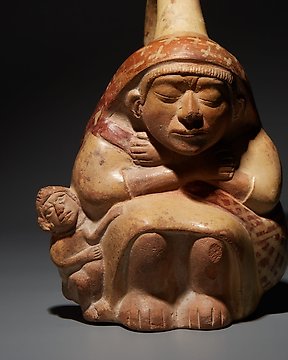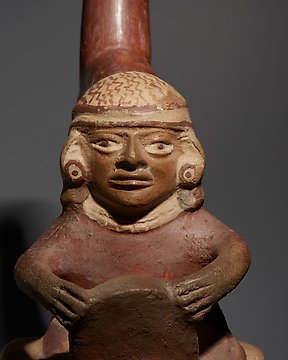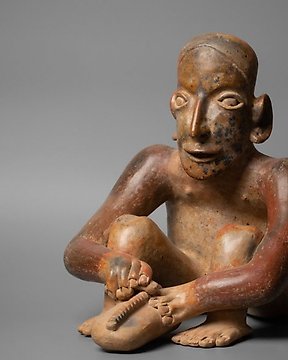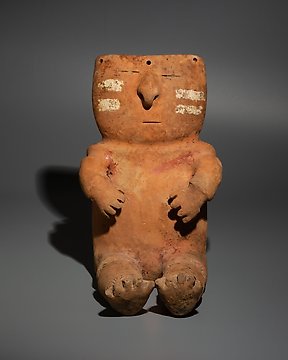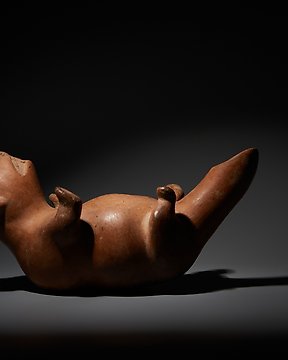super 💯💯💯💯💯
Se översättningMaya Terrakotta Huvud för en skulptur. 400 - 600 e.Kr. 19,5 cm höjd. Spansk exportlicens. TL-test.
Nr 85410107
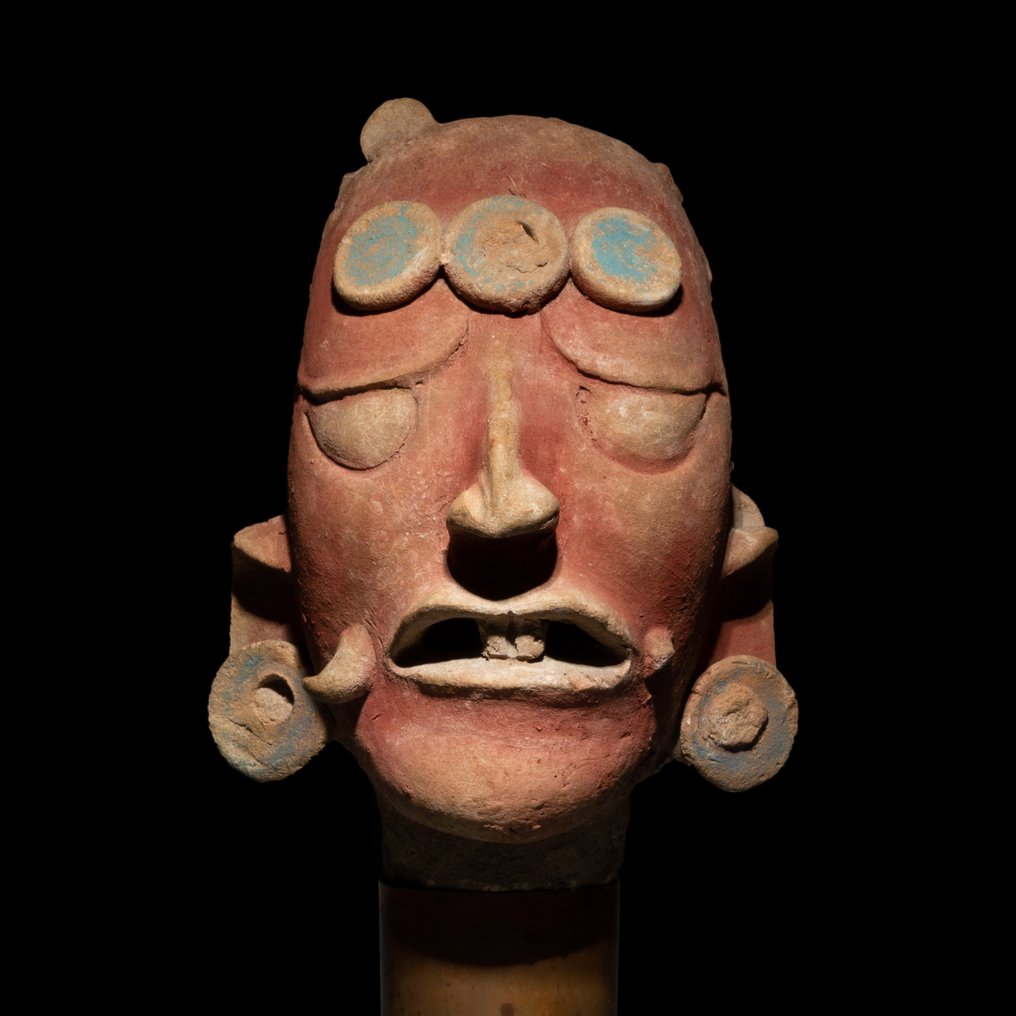

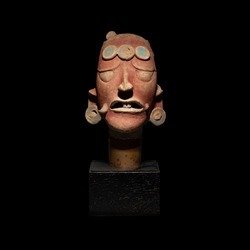
Dignatary
- fine quality -
- Thermoluminescence test attached -
Maya
400 - 600 AD.
MATERIAL: Terracotta.
SIZE: Height 19.5 cm.
PROVENANCE:
- Private collection, Mr. B., Dallas, USA 1983.
- Private collection, M. G., Barcelona.
CONDITION: Good general condition, both scenes are intact, with restored tear lines on the base and sides.
DESCRIPTION:
The Maya culture developed over an extensive area, from south-central Mexico to Guatemala and Honduras. This area is composed of three different regions: the mountains or Highlands, the tropical jungle or Lowlands and the lowlands of the Gulf of Mexico and the Yucatan Peninsula, each with its own differentiated resources. The activity of the Maya during the classic period was centered in the Highlands and Lowlands, whose most important centers were Tikal and Kaminaljuyú, respectively.
This culture began to form from the first village and agricultural groups that inhabited the area and participated in the sphere of exchange and influence of groups from central Mexico, mainly the Olmecs. Around the 10th century A.D., possibly as a result of the lack of rainfall, the deterioration of the ecological system and social discontent, the main civic-ceremonial centers were abandoned. Later, populations of Mayan origin would have settled in the Yucatan peninsula and together with groups from central Mexico, mainly Toltecs, would form new centers, such as Chichen Itza and Mayapan, which would last until the arrival of the Spaniards in 1525. Even today there are towns that belong to the Mayan tradition, from Yucatan to Honduras, and that continue with the way of life, clothing and language of this ancient culture.
The basis of their economy was slash-and-burn agriculture in cultivated fields or milpas, sowing, with the help of sharpened sticks, mainly corn, squash, chili and beans. They worked four months a year and, due to erosion, the land had to be constantly rotated. In addition, they gathered large quantities of vegetables and wild fruits, hunted wild animals, extracted honey from beehives and fished in the sea, lakes and rivers. As resources were different in each region, exchange played a fundamental role. The Maya were able to measure time and the movements of the earth and the stars, based on calculations made by a vigesimal mathematical system. They developed two calendars, a solar calendar or haab (of 365 days with 18 months of 20 days, plus an additional 5 days) and a lunar calendar or tzolkin (of 260 days), which regulated civil and religious activities respectively. Both acted simultaneously, in a calendrical wheel, which after 52 years closed a cycle and events repeated themselves again. In addition, based on the legacy left by the Olmec culture, the Maya developed a writing of glyphs or signs that were distributed in two columns, read from left to right and from top to bottom. This is found on the walls and stairways of important buildings, in ceramics and in books or codices made of amate paper or deer skin.
They developed a unique artistic style with a complexity that is often compared to European baroque. They represented the human being in a very realistic way and with correct anatomical proportions, in naturalistic poses and with emphasis on movement. The main themes of their art were sacred, ritual and hierarchical, although there are also scenes of daily life and local fauna, such as the monkey, tapir, jaguar, bat, quetzal, fish and turtles. Stone was one of the most used raw materials, with which buildings were constructed and stelae, sculptures and different bas-reliefs and super-reliefs that adorn the constructions were carved. In architecture they introduced the stela-altar, the arch and the false vault. In addition to monumental art, personal aesthetics was also important and for this reason they made jade ornaments, such as earrings, earrings, necklaces and masks, they deformed their skulls and noses and hung an ornament on their foreheads to make them look like turnips. Their pottery, decorated with paintings and engravings, offers many of the finest pieces of pre-Columbian art, the most common forms being vases, bowls and incense burners. The former usually contain texts written with the glyph system developed by this culture.
The cult was fundamental for the Maya, since they conceived the earthly and supernatural world, lower or dark and higher or celestial, as a unity in which human beings, deities, animals and plants were closely linked by destiny from birth. That is why they went to the great civic-religious centers in search of the horoscope and offered blood from their fingertips, earlobes or tongue, which was deposited in the altars erected in front of the stelae. The pantheon was ample, emphasizing the creator god Hunab Ku and the god of the Night that inhabited the underworld: the god Ah Puch. In addition, they venerated the Sun, the Moon, Venus and other celestial bodies and phenomena such as rain, whose representative was Chaac. On the other hand, there were tutelary gods of the different social groups and specialists, such as Kukulcan, the Feathered Serpent, associated with the ruling class, and Ek Chuah, linked to merchants and cacao producers. When dying, the individual could, depending on his merits, go to rest eternally in one of the heavens, under the leafy shade of the ceiba tree, or permanently suffer the torments of hunger and cold in the dark underworld. If he was a peasant, he was buried in the surroundings of the hut where he had died; if he was a nobleman, he was cremated and his ashes were deposited in urns, inside subway vaults. If he was a ruler, a pyramidal temple was built as a burial place.
Notes:
The seller guarantees that he acquired this piece according to all national and international laws related to the ownership of cultural property. Provenance statement seen by Catawiki.
The seller will take care that any necessary permits, like an export license will be arranged, he will inform the buyer about the status of it if this takes more than a few days.
The piece includes authenticity certificate.
The piece includes Spanish Export License.
#masterpieces
Säljarens berättelse
Dignatary
- fine quality -
- Thermoluminescence test attached -
Maya
400 - 600 AD.
MATERIAL: Terracotta.
SIZE: Height 19.5 cm.
PROVENANCE:
- Private collection, Mr. B., Dallas, USA 1983.
- Private collection, M. G., Barcelona.
CONDITION: Good general condition, both scenes are intact, with restored tear lines on the base and sides.
DESCRIPTION:
The Maya culture developed over an extensive area, from south-central Mexico to Guatemala and Honduras. This area is composed of three different regions: the mountains or Highlands, the tropical jungle or Lowlands and the lowlands of the Gulf of Mexico and the Yucatan Peninsula, each with its own differentiated resources. The activity of the Maya during the classic period was centered in the Highlands and Lowlands, whose most important centers were Tikal and Kaminaljuyú, respectively.
This culture began to form from the first village and agricultural groups that inhabited the area and participated in the sphere of exchange and influence of groups from central Mexico, mainly the Olmecs. Around the 10th century A.D., possibly as a result of the lack of rainfall, the deterioration of the ecological system and social discontent, the main civic-ceremonial centers were abandoned. Later, populations of Mayan origin would have settled in the Yucatan peninsula and together with groups from central Mexico, mainly Toltecs, would form new centers, such as Chichen Itza and Mayapan, which would last until the arrival of the Spaniards in 1525. Even today there are towns that belong to the Mayan tradition, from Yucatan to Honduras, and that continue with the way of life, clothing and language of this ancient culture.
The basis of their economy was slash-and-burn agriculture in cultivated fields or milpas, sowing, with the help of sharpened sticks, mainly corn, squash, chili and beans. They worked four months a year and, due to erosion, the land had to be constantly rotated. In addition, they gathered large quantities of vegetables and wild fruits, hunted wild animals, extracted honey from beehives and fished in the sea, lakes and rivers. As resources were different in each region, exchange played a fundamental role. The Maya were able to measure time and the movements of the earth and the stars, based on calculations made by a vigesimal mathematical system. They developed two calendars, a solar calendar or haab (of 365 days with 18 months of 20 days, plus an additional 5 days) and a lunar calendar or tzolkin (of 260 days), which regulated civil and religious activities respectively. Both acted simultaneously, in a calendrical wheel, which after 52 years closed a cycle and events repeated themselves again. In addition, based on the legacy left by the Olmec culture, the Maya developed a writing of glyphs or signs that were distributed in two columns, read from left to right and from top to bottom. This is found on the walls and stairways of important buildings, in ceramics and in books or codices made of amate paper or deer skin.
They developed a unique artistic style with a complexity that is often compared to European baroque. They represented the human being in a very realistic way and with correct anatomical proportions, in naturalistic poses and with emphasis on movement. The main themes of their art were sacred, ritual and hierarchical, although there are also scenes of daily life and local fauna, such as the monkey, tapir, jaguar, bat, quetzal, fish and turtles. Stone was one of the most used raw materials, with which buildings were constructed and stelae, sculptures and different bas-reliefs and super-reliefs that adorn the constructions were carved. In architecture they introduced the stela-altar, the arch and the false vault. In addition to monumental art, personal aesthetics was also important and for this reason they made jade ornaments, such as earrings, earrings, necklaces and masks, they deformed their skulls and noses and hung an ornament on their foreheads to make them look like turnips. Their pottery, decorated with paintings and engravings, offers many of the finest pieces of pre-Columbian art, the most common forms being vases, bowls and incense burners. The former usually contain texts written with the glyph system developed by this culture.
The cult was fundamental for the Maya, since they conceived the earthly and supernatural world, lower or dark and higher or celestial, as a unity in which human beings, deities, animals and plants were closely linked by destiny from birth. That is why they went to the great civic-religious centers in search of the horoscope and offered blood from their fingertips, earlobes or tongue, which was deposited in the altars erected in front of the stelae. The pantheon was ample, emphasizing the creator god Hunab Ku and the god of the Night that inhabited the underworld: the god Ah Puch. In addition, they venerated the Sun, the Moon, Venus and other celestial bodies and phenomena such as rain, whose representative was Chaac. On the other hand, there were tutelary gods of the different social groups and specialists, such as Kukulcan, the Feathered Serpent, associated with the ruling class, and Ek Chuah, linked to merchants and cacao producers. When dying, the individual could, depending on his merits, go to rest eternally in one of the heavens, under the leafy shade of the ceiba tree, or permanently suffer the torments of hunger and cold in the dark underworld. If he was a peasant, he was buried in the surroundings of the hut where he had died; if he was a nobleman, he was cremated and his ashes were deposited in urns, inside subway vaults. If he was a ruler, a pyramidal temple was built as a burial place.
Notes:
The seller guarantees that he acquired this piece according to all national and international laws related to the ownership of cultural property. Provenance statement seen by Catawiki.
The seller will take care that any necessary permits, like an export license will be arranged, he will inform the buyer about the status of it if this takes more than a few days.
The piece includes authenticity certificate.
The piece includes Spanish Export License.
#masterpieces
Säljarens berättelse
- 751
- 7
- 0
Il pezzo è arrivato in condizioni perfette il pacco era protetto alla perfezione
Se översättningBuenos días, señor. ¡Gracias por las precauciones de embalaje Tip / Top! Muy contento con mi compra. ¡Gracias!
Se översättningPerfecto! :)
Se översättningWunderbares Stück. Alles wie beschrieben. Hervorragender Kontakt.
Se översättningExtremely rapid courrier service from Barcelona to Flanders, picture was nicely and carefully packaged. Muchas gracias!
Se översättningVery fine specimen! Thanks.
Se översättninggoede foto's, goede omschrijving, goed verpakt en snel verzonden.
Se översättningmolto bello tutto ok
Se översättningPezzo come da descrizione, davvero notevole. Venditore molto consigliato in quanto gentile e disponibile. spedizione molto veloce. Ottimo!
Se översättningVenditore davvero ottimo e gentile. Merce come da descrizione, spedizione veloce. Ottimo l'avere certificato di autenticità.
Se översättningUn 100 como empresa un 100 como envío . Empresa muy especial con mucha exquisitez en todos los productos y en personal . Muchas gracias
Se översättningAll well! Thanks.
Se översättningVery nice and fine cut little jewel! Well packed too! Thanks!
Se översättningnice piece and very fast shipping!
Se översättningEs una maravilla de moneda, donde se le nota los pasos de los años y me encanta. Servido muy rápido y bien empaquetado. Con su certificación. Qué más se puede pedir?
Se översättningSnelle en correcte levering, alleen was de verpakking voor het schilderij niet stevig genoeg.
Se översättningHerzlichen Dank!
Se översättningAll OK and with very fast shipping.
Se översättningPrachtig schilderij. Zo blij mee. Zeer nette verkoper en zeer snelle levering.
Se översättningperfect ! very fast and high quality delivery !
Se översättningAll well! Thanks.
Se översättningVendeur très professionnel, top +++×
Se översättningPhotos trop contrastées pour bien percevoir les défauts, mais ces défauts étaient visibles pour autant. Le "Bon état" est trompeur. Sinon, envoi rapide et correctement emballé. Frais de port exagérés.
Se översättningAnsvarsfriskrivning
Säljaren garanterar och kan bevisa att objektet införskaffats på lagligt sätt. Säljaren har informerats av Catawiki att de måste lämna den dokumentation som är obligatorisk enligt lagar och regler i det land de är bosatta. Säljaren garanterar och har rätt att sälja/exportera detta objekt. Säljaren tillhandahåller all information om härkomst som är känd om objektet till köparen. Säljaren säkerställer att alla nödvändiga tillstånd är/kommer att bli ordnade. Säljaren informerar köparen omedelbart om eventuella förseningar gällande att anskaffa sådana tillstånd.
Säljaren garanterar och kan bevisa att objektet införskaffats på lagligt sätt. Säljaren har informerats av Catawiki att de måste lämna den dokumentation som är obligatorisk enligt lagar och regler i det land de är bosatta. Säljaren garanterar och har rätt att sälja/exportera detta objekt. Säljaren tillhandahåller all information om härkomst som är känd om objektet till köparen. Säljaren säkerställer att alla nödvändiga tillstånd är/kommer att bli ordnade. Säljaren informerar köparen omedelbart om eventuella förseningar gällande att anskaffa sådana tillstånd.

